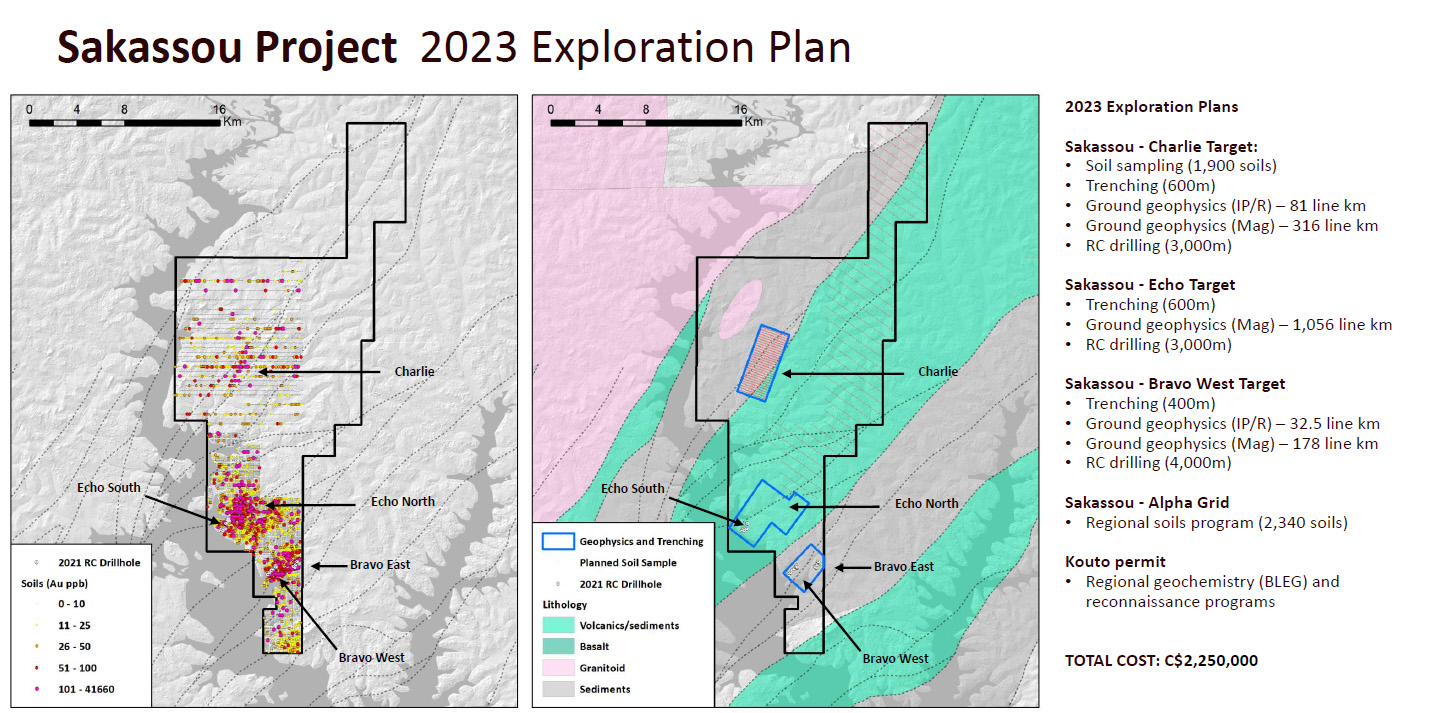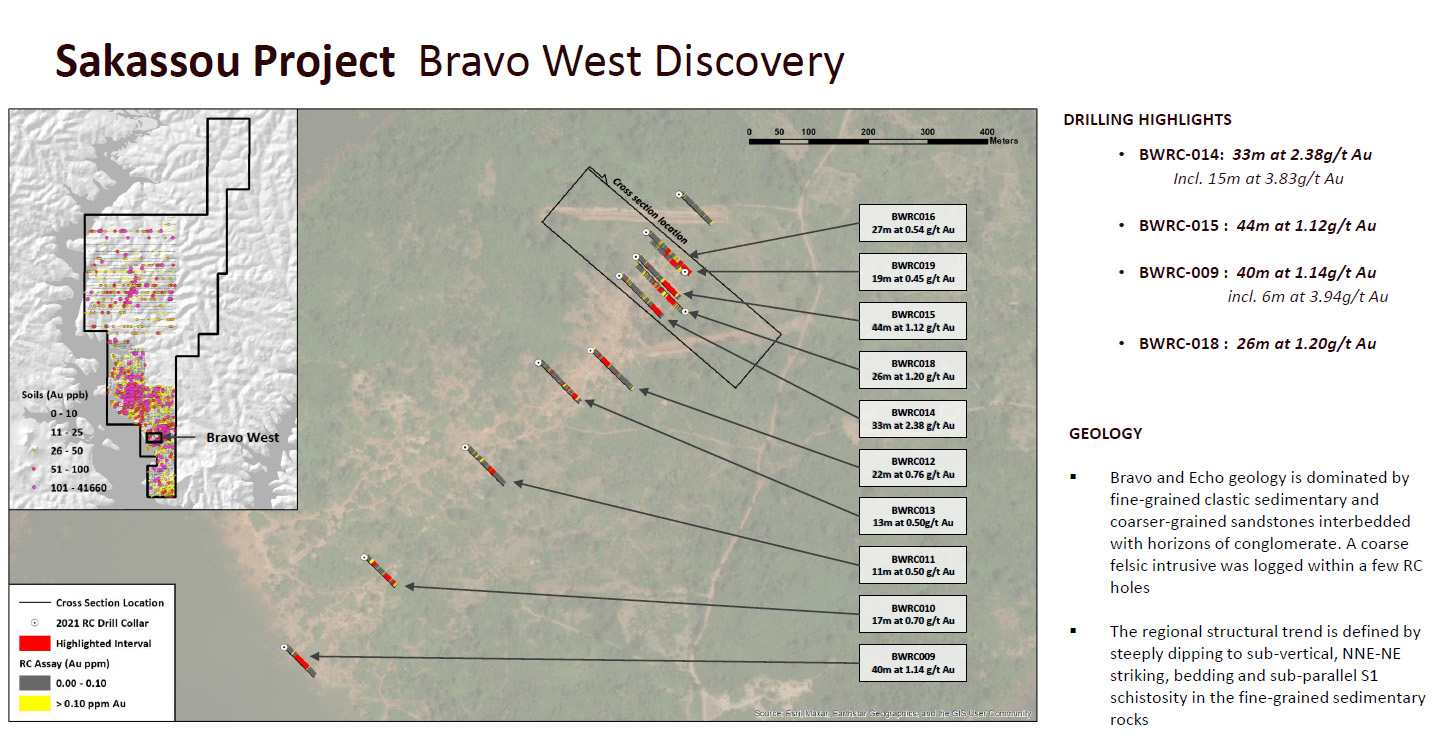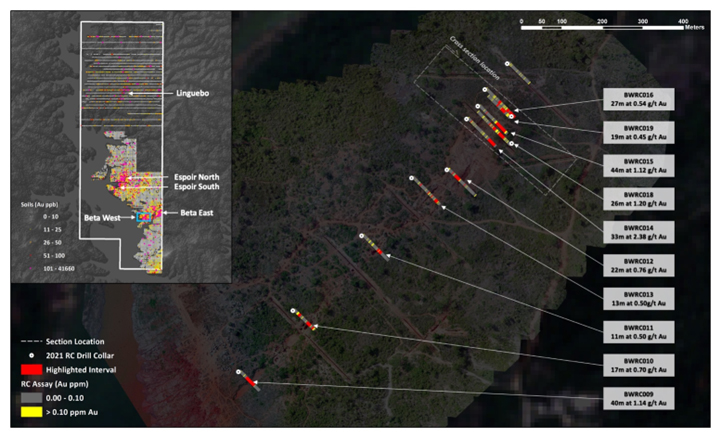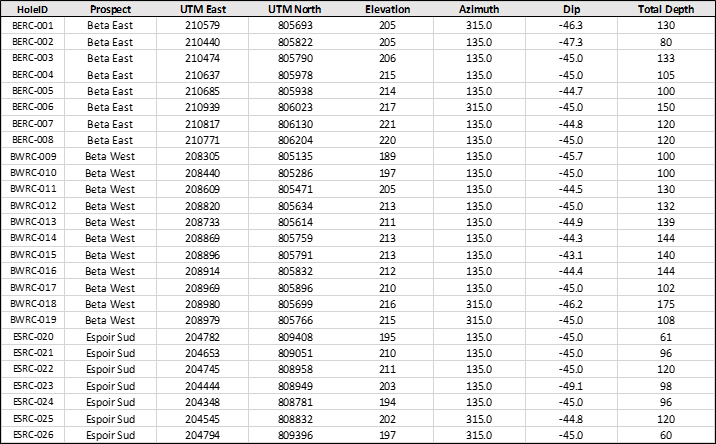Koulou Gold Corp.
1570 – 1111 West Georgia Street,
Vancouver, BC V6E 4M3
Canada
info@koulougoldcorp.com
Sakassou Project
The Sakassou permit is located in the Bouafle greenstone belt ~30 kilometres North West of Perseus Mining's (TSX:PRU) Yaoure-Angovia gold deposit. The Sakassou Project currently has 3 target areas: Charlie, Echo, and Bravo.
2021 Drill Program
Drill results from the maiden reconnaissance reverse circulation (RC) drill program, including 3,003m of drilling, at the Sakassou Project, located in Côte d’Ivoire, West Africa, include the following highlights:
- BWRC-014 33m at 2.38g/t Au including 15m at 3.83g/t Au from 118m
- BWRC-015 44m at 1.12g/t Au
- BWRC-009 40m at 1.14g/t Au including 6m at 3.94g/t Au from 60m
- BWRC-018 26m at 1.20g/t Au
- ESRC-026 5m at 6.94 g/t Au
The 2021 drill program was designed to test along mineralized structures defined by large-scale artisanal workings as well as significant gold-in-soil anomalies at three target areas; Beta (Bravo) East, Beta (Bravo) West, and Espoir (Echo) South, all located in the southernmost portion of the project area. Assay results demonstrate the presence of a significant structurally controlled gold system at Bravo West. The 2021 RC drill program represents the first known drill campaign carried out at Sakassou including the initial test of these three greenfields exploration targets.
Plan Map at Beta (Bravo) West
Discussion of Results
The geology of the Bravo and Echo target areas is dominated by fine-grained clastic sedimentary rocks including siltstone and shale as well as coarser grained sandstones interbedded with horizons of conglomerate. The regional structural trend at Sakassou is defined by steeply dipping to sub-vertical, NNE-NE striking, bedding and sub-parallel S1 schistosity in the fine-grained sedimentary rocks. At Bravo West, a coarser-grained unit, up to 20 to 40 meters in width was described as intrusive, possibly a tonalite. Gold mineralization at Sakassou is characterized by disseminated pyrite associated with a well-developed quartz stockwork. Veining is generally hosted within coarser, more competent sedimentary strata (sandstone + conglomerate) and intrusives, which preferentially crack and give way to veins during deformation.
At Bravo West, 11 holes, totaling 1414 meters were drilled along a one-kilometer-strike and beneath significant artisanal workings. The best results included BWRC-014 intersecting 2.38g/t Au over 33m beneath the largest artisanal pit in the area. Approximately one kilometer to the southwest, BWRC-009 intercepted 1.14g/t Au over 40m across the same mineralized structure. The structure is open to the northeast and the gold-in-soil geochemical anomaly extends for a further one kilometer beyond the current drilling, making the Beta West discovery a priority for follow-up exploration.
At Echo South, 7 holes, totalling 651m were drilled to test the southern extent of a soil anomaly coincident with artisanal workings. ESRC-026 which ended in mineralization intersected 6.94 g/t Au over 5m from 26m depth and included the highest grade sample of 28.45 g/t Au in undifferentiated weathered material. ESRC-025 intercepted 0.46g/t Au over 18m in the coarser sedimentary unit. The Echo area has significant upside potential along strike at Echo North, which is defined by a much larger soil anomaly than Echo South. Echo South was prioritized for drilling during the 2021 campaign based on the presence of artisanal workings.
At Bravo East, 8 holes over three fences, totaling 938m were drilled beneath artisanal workings covering 500m in strike length. BERC-004 intersected 1.00g/t Au over 14m within the fine-grain metasediment. BERC-006 intercepted 1.55g/t Au over 5m within a coarser unit near the contact with the fine-grain metasediment. Based on these results, Bravo East ranks as a lower priority target.
Following the overall positive results of the initial RC drilling program at Bravo West and Echo South, in addition to the presence a significant untested three-kilometer-long gold-in-soil geochemical anomaly at Linguebo (Charlie) as well the other extensive and untested soil anomaly at Echo North, the Company will proceed with the next phase of exploration, including a detailed airborne magnetic survey, a ground induced polarization (IP) survey, additional soil sampling and trenching, as well as additional RC and air-core drilling.
Location Map of the Sakassou Project and Target Areas
Table of Results
Drill Collar Table
QA/QC and Sampling Protocols
All RC drilling samples were collected under the supervision of Koulou Gold employees. Samples were logged, photographed and collected at the drill site while drilling. Samples were then bagged, and blanks and certified reference materials were inserted at regular intervals before being transported to a storage facility at the Company’s camp. Prior to being shipped off site, groups of samples were placed in large bags, sealed with numbered tags in order to maintain a chain-of-custody, and transported to MSALABS laboratory in Yamoussoukro, Cote D’Ivoire.
Sample preparation and analytical work for this drill program were carried out by MSALABS. Samples were prepared for analysis according to MSALABS method PRP-920, PRP-QCC, PRP-QCP: individual samples were crushed to 2mm (10 mesh) and a 1kg split was pulverized to 85% -75μm (200 mesh) for analysis and then assayed for gold. Gold in samples were analyzed using MSALABS method FAS-121 where a 50g split is analyzed with fire assay by Pb collection and AAS finish. All results passed the QA/QC screening at the lab, all company inserted standards and blanks returned results that were within acceptable limits.
Qualified Person
Mr. Janek Wozniewski, B. Sc., P. Geo., “Qualified Person” under National Instrument 43-101, has reviewed and approved the scientific and technical information in this website.







